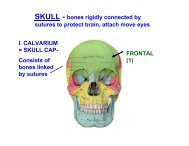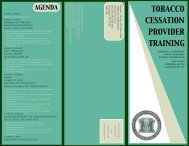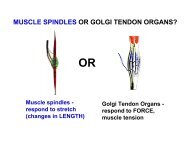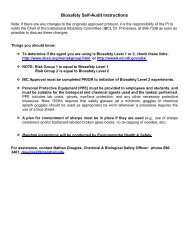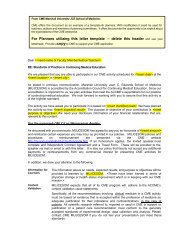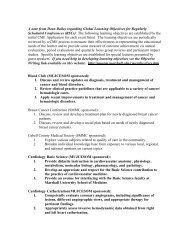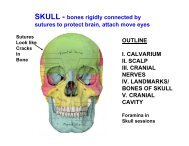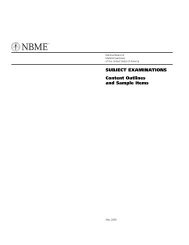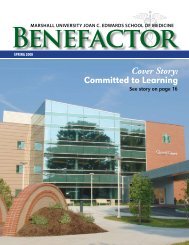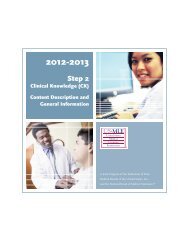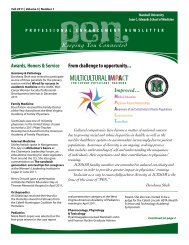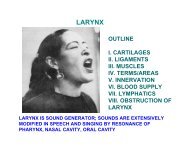Program Director/Principal Investigator (Last, First, Middle): Rankin, Gary O 68hyperlipidemia diagnosis: an update. Vasc. Health Risk Manag. 3: 877-886 (2007)3. A Sniderman, SD Bailey, JC Engert. Familial combined hyperlipidemia: how can geneticdisorders be common, complex and comprehensible? Clin. Sci. 113: 356-367 (2007)4. AS Weirzbicki, CA Graham, IS Young, DP Nicholls. Familial Combined Hyperlipidaemia: Under-Defined and Under- Diagnosed? Curr. Vasc. Pharmacol. 6: 13-22 (2008)5. AG Motulsky and JD Brunzell. Genetics <strong>of</strong> coronary atherosclerosis. In: The Genetic Basis <strong>of</strong>Common Diseases. Edited by RA King, JI Rotter, and AG Motulsky. 2nd Edition.6. JL Goldstein, HG Schrott, WR Bierman, AG Motulsky. Hyperlipidemia in coronary heart diseaseII. Genetic analysis <strong>of</strong> lipid levels in 176 families and delineation <strong>of</strong> a new inherited disorder,combined hyperlipidemia. J. Clin. Invest. 52: 1544-1568 (1973)7. EA Nikkila and A Aro. Family study <strong>of</strong> serum lipids and lipoproteins in coronary heart disease.Lancet 1: 954-959 (1973)8. E. Suviolahti,HE Lilja, P Pajukanta. Unraveling the complex genetics <strong>of</strong> familial combinedhyperlipidemia. Ann. Med. 38: 337-351 (2006)9. K Kristiansson, E Ilveskoski, T Lehtimaki, L Peltonen, M Perola, PJ Karhunen. AssociationAnalysis <strong>of</strong> Allelic Variants <strong>of</strong> USF1 in Coronary Atherosclerosis. Arterioscler. Thromb. Vasc. Biol.28: 983-989 (2008)10. P. Pajukanta, H Allayee, KL Krass, A Kuraishy, A Soro, HE Lilja, R Mar, M-R Taskinen, I Nuotio,M Laakso, JI Rotter, TWA de Bruin, RM Cantor, AJ Lusis, L Peltonen. Combined analysis <strong>of</strong>genome scans <strong>of</strong> Dutch and Finnish families reveals a susceptibility locus for high-densitylipoprotein cholesterol on chromosome 16q. Am. J. Hum. Genet. 72: 903-917 (2003)11. P Pajukanta, I Nuotio, JD Terwilliger, KVK Porkka, K Ylitalo, J Pihlajamaki, AJ Suomalainen, A-CSyvanen, T Lehtimaki, JSA Viikari, M Laakso, M-R Taskinen, C Ehnholm, L Peltonen. Linkage <strong>of</strong>familial combined hyperlipidaemia to chromosome 1q21-q23. Nat. Genet. 18: 369-373 (1998)12. RP Naoumova, SA Bonney, S Eichhenbaum-Voline, HN Patel, B Jones, EL Jones, J Amey, SColilla, CKY Neuwirth, R Allotey, M Seed, DJ Betteridge, DJ Galton, NJ Cox, GI Bell, J Scott, CCShoulders. Confirmed locus on chromosome 11p and candidate loci on 6q and 8p for thetriglyceride and cholesterol traits <strong>of</strong> combined hyperlipidemia. Arterioscler. Thromb. Vasc. Biol. 23:2070-2077 (2003)13. GM Dallinga-Thie, M van Linde-Sibenius Trip, JI Rotter, RM Cantor, X Bu, AJ Lusis and TW deBruin. Complex genetic contribution <strong>of</strong> the AI-CII-AIV gene cluster to familial combinedhyperlipidemia. J. Clin. Invest. 99: 953-961 (1997)14. BE Aouizerat, H Allayee, RM Cantor, RC Davis, CD Lanning, PZ Wen, GM Dallinga-Thie, TW deBruin, JI Rotter, AJ Lusis. A genome scan for familial combined hyperlipidemia reveals evidence <strong>of</strong>linkage with a locus on chromosome 11. Am. J. Hum. Genet. 65:397-412 (1999).15. JA Cortner, PM Coates, and PR Gallagher. Prevalence and expression <strong>of</strong> familial combinedhyperlipidemia in childhood. J. Pediatr. 116: 514-519 (1990)16. R Shamir, AM Tershakovec, PR Gallaher, CA Liacouras, LL Hayman, JA Cortner. The influence<strong>of</strong> age and relative weight on the presentation <strong>of</strong> familial combined hyperlipidemia in childhood.Atherosclerosis 121: 85-91 (1996)17. L Pisciotta, T Fasano, L Calabresi, A Bellocchio, R Fresa, C Borrini, S Calandra, S Bertolini. Anovel mutation <strong>of</strong> the apolipoprotein A-I gene in a family with familial combined hyperlipidemia.Atherosclerosis 198: 145-151 (2008)18. P. Pajukanta, HE Lilja, JS Sinsheimer, RM Cantor, AJ Lusis, M Gentile, XJ Duan, ASoro-Paavonen, J Naukkarinen, J Saarela, M Laakso, C Ehnholm, MR Taskinen, L Peltonen.Familial combined hyperlipidemia is associated with upstream transcription factor 1 (USF1). Nat.Genet. 36: 371-376 (2004)19. J Naukkarinen, M Gentile, A Soro-Paavonen, J Saarela, HA Koistinen, P Pajukanta, M Taskinen,and L Peltonen. USF1 and dyslipidemias: converging evidence for a functional intronic variant.Hum. Mol. Genet. 14: 2595-2605 (2005)20. A Huertas-Vazquez, CL Plaisier, R Geng, BE Haas, J Lee, MM Greevenbroek, C van der Kallen,TW de Bruin, MR Taskinen, KN Alagramam, P Pajukanta. A nonsynonymous SNP within PCDH15PHS 2590 (Rev. 06/09)Continuation Format Page
Program Director/Principal Investigator (Last, First, Middle): Rankin, Gary O 69is associated with lipid traits in familial combined hyperlipidemia. Hum. Genet. 127: 83-9, 2010.21. GS Berenson, SR Srinivasan, W Bao, WPIII Newman, RE Tracy, WA Wattigney. Associationbetween multiple cardiovascular risk factors and the early development <strong>of</strong> atherosclerosis.Bogalusa Heart Study. N. Engl. J. Med. 338:1650–1656 (1998)22. SR Daniels, FR Greer, and the Committee on Nutrition. Lipid Screening and CardiovascularHealth in Childhood Pediatrics 122: 198-208 (2008)23. Y Kuromori, T Okada, F Iwata, M Hara, N Noto, K Harada. Familial combined hyperlipidemia(FCHL) in children: The significance <strong>of</strong> early development <strong>of</strong> hyperapoB lipoproteinemia, obesityand aging. J. Atheroscler. Throm. 9: 314-320 (2002)24. Ng SB, Bigham AW, Buckingham KJ, et al. Exome sequencing identifies MLL2 mutations as acause <strong>of</strong> Kabuki syndrome. Nature Genetics 2010(a), 42:790-3.25. Ng SB, Buckingham KJ, Lee C, et al. Exome sequencing identifies the cause <strong>of</strong> a mendeliandisorder. Nature Genetics 2010(b), 42:30-35.26. Sobreira NL, Cirulli ET, Avramopoulos D, Wohler E, Oswald GL, Stevens EL, Ge D, ShiannaKV, Smith JP, Maia JM, Gumbs CE, Pevsner J, Thomas G, Valle D, Hoover-Fong JE, GoldsteinDB. Whole-genome sequencing <strong>of</strong> a single proband together with linkage analysis identifies aMendelian disease gene. PLoS Genetics 2010, 6:e100099127. Cirulli ET, Goldstein DB. Uncovering the roles <strong>of</strong> rare variants in common disease throughwhole-genome sequencing. Nature Reviews Genetics 2010, 11:415-25.28. Civeira F, Jarauta E, Cenarro A, et al. Frequency <strong>of</strong> Low-Density Lipoprotein Receptor GeneMutations in Patients With a Clinical Diagnosis <strong>of</strong> Familial Combined Hyperlipidemia in a ClinicalSetting. Journal <strong>of</strong> the American College <strong>of</strong> Cardiology 2008, 52:1546-53.29. Jarvik GP, Brunzell JD, Motulsky AG. Frequent Detection <strong>of</strong> Familial HypercholesterolemiaMutations in Familial Combined Hyperlipidemia. Journal <strong>of</strong> the American College <strong>of</strong> Cardiology2008, 52:1554-6.30. Van Leuven F, Thiry E, Lambrechts M, et al. Sequencing <strong>of</strong> the coding exons <strong>of</strong> the LRP1 andLDLR genes on individual DNA samples reveals novel mutations in both genes. Atherosclerosis2001, 154:567-577.PROTECTION AGAINST RESEARCH RISKSY 1. Will human subjects be involved next year?If yes, provide complete the above Targeted/Planned Enrollment Table and the Inclusion Enrollment<strong>Report</strong>. Provide the date <strong>of</strong> IRB approval and enclose with transmittal.03/25/2011;01/25/2012N 2. Will vertebrate animals be used next year?Y 3. Will recombinant DNA experiment(s) be conducted next year?If yes, provide the date <strong>of</strong> Office <strong>of</strong> Recombinant DNA Activities (ORDA), NIH approval:EXEMPTY 4. Are there potential hazards to laboratory workers (carcinogens, pathogens, ionizing radiation, etc.)involved in the proposed research for next year? If yes, identify:NBloodborne pathogens, human cell lines5. Will any <strong>of</strong> the research-risk categories,not involved next year, be involved future years? If yes, identify:PHS 2590 (Rev. 06/09)Continuation Format Page



